Dams can be expensive to build and therefore a farmer should do his calculations and planning very carefully to prevent those hidden costs from rising out of control. Water seepage can also be a huge unplanned expense, but it can be reduced to a minimum through proper planning.
The building cost of a storage dam is a function of:
- The required preparation of the site.
- The quantity of building material needed, i.e. soil, pipes, cement, sand, quarry stone, etc.
- The availability of the building material and the transport distance.
- Working with soils with long hauling distances increase difficulty and the cost of an earth dam considerably.
- The quality of the foundation and the necessary preparation thereof.
- The spillway as required by the design.
- An outlet pipe is required, namely type, diameter and length with valves and necessary cut-off walls.
- Fencing of structure, if necessary.
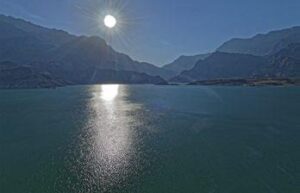
Evaporation is something to bring into account when designing a dam. Photo: Makal, Pixabay.
Natural losses of stored water
Seepage
Seepage usually occurs in two ways, namely through the basin of the dam or through the wall. This is a result of permeable formations that the dam basin consists of or faults in the structure itself.
To prevent seepage through the wall or foundation, provision must be made in the design to ensure a denser structure. In the case of an earth dam, the foundation and topsoil must be of a reasonably dense type; where this is not the case, the construction of a pit wall, clay core or a clay blanket must be considered.
A certain measure of seepage occurs in most dam basins. The amount of seepage is difficult to determine. If there is fine silt in the run-off water, the deposit of the silt in the basin will reduce the seepage. If the basin of the dam is very permeable, a blanket of clay can be placed over the entire basin, which will be described in a future article.
It is therefore preferable that the building ground and the dam basin be dense or compacted economically where the storage of water is a prerequisite.
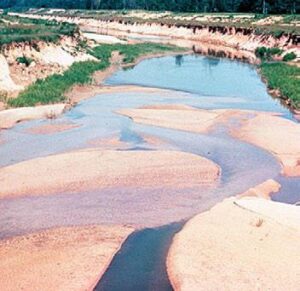
Silting of a dam. Photo: educalingo.com.
Evaporation
The average gross evaporation figure for Southern Africa from a free water surface is approximately 2 m per year.
It varies from approximately 1,2 m per year in the south and east to about 3 m per year in the dry, warm regions. Preference is therefore given to dam sites which are relatively deep and have small surface areas.
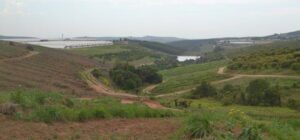
Annual run-off is influenced by factors like topography, rainfall and vegetation.
Silting of dams
When muddy water flows into a dam basin, the larger and heavier sediments tend to settle first, but the finer material in suspension moves toward the dam wall.
Earth dams with exceptional long walls and side spillways must not be designed in regions where the run-off water contains a high percentage of sediments, because delta forming takes place. The lifespan of such a dam is extremely limited. After silting, it will eventually fail and cause flooding. In the choice of an earth dam with a side spillway, the catchment area must be well covered with vegetation and if fields are present, it must be mechanically and biologically protected against erosion.

Is your dam compliant with your local water acts? Photo: Hans Braxmeier, Pixabay.
Catchment areas and run-off
Annual run-off
The amount of run-off, regarding flood peaks, as well as the average annual run-off is in a certain direct relation with the size of the catchment area. Other factors, such as annual rainfall, intensities and seasonal distribution of rainfall, vegetation, topography, mother rock, type and depth of the soil and water use in the catchment area, each play particular roles in determining the run-off, regarding both the average annual run-off and the run-off flood peaks.
Various hydrological models exist that use the above factors to determine run-off intensities, average annual run-offs, flood sizes and the catchment water delivery potential. The models each have specific application ranges and are used by specialists. Methods that can be used for first order approximations exist for small catchment areas. Examples of flood approximation models are: Unit hydrograph, SCS, Rational, and Roberts. The ACRU-model of the University of KwaZulu-Natal in South Africa is a computer-supported model that not only calculates run-off, but also handle s dam balances, risk analysis, etc. An indication of a few hydrological models, with an indication of catchment area size applications is given in Table 1.

Table 1: Hydrological models with catchment area sizes
Table 2: Average annual run-off
Regarding annual run-off, the following two distinctions can be made:
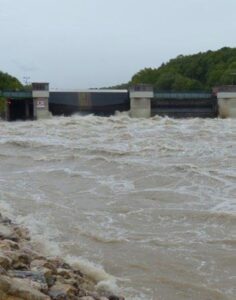
Temporary run-off after a rain shower. Photo: Hans Braxmeier, Pixabay.
Permanent flow
This is water from consistent fountains or streams. The volume can usually be determined by means of some or other simple method of stream measurement.
Temporary run-off
This is the run-off that persists during rain showers up to a few days after the showers and it is difficult to determine the extent thereof.
Table 2 provides the amount of water that can normally be expected annually in the different rainfall regions from a catchment area of one km². These results are only averages based on the average values regarding factors such as rainfall, topography, vegetation, soil depth and infiltration.

Table 3: Dam safety risk groupings
Run-off flood peaks
There are various methods according to which the flood peak can be determined, namely:
- By using the rational formula for catchment area of one km² and smaller
- By using the Department of Water Affairs and Forestry’s method of calculating run-off flood peaks
Various sources for the calculation of run-off flood peaks are available.
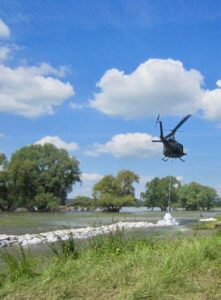
A large dam should be designed for a 50 to 100 year peak flow. Photo: tunfux, Pixabay.
Storage capacity of dam basin and run-off
A healthy relation must exist between the size of the catchment area and the storage capacity of the dam basin. If the catchment area is small and the storage capacity of the dam basin is large, there is a slight chance that the dam will fill up. Such a design is uneconomical and the flood plain downstream is deprived of run-off water, which is extremely essential for the biological maintenance thereof.
If the catchment area is relatively large and the storage capacity of the dam basin is small, a large, expensive spillway will be required.
It is therefore recommended that the maximum storage capacity of a farm dam must normally not be more than half of the expected annual run-off.
Apart from the practical implications that the capacity of storage dams may have, it may not exceed the regulations of the country’s water act and the necessary authorisation must be obtained beforehand from the relative department. In the case of large dams, an environmental impact assessment might be required.
The danger potential
The proposed dam’s potential as source of danger for life, private and public property and installations, such as roads, rail, buildings, etc. must be considered thoroughly. The danger potential will influence the design and cost of construction to a large extent. The dam safety legislation of your country must be consulted and adhered to.
Extremely small dams must be designed to allow a peak flood to flow safely, which can occur every ten years. Larger dams with a low danger potential, is designed for a 20 to 30 year frequency.
Larger or more expensive dams with a greater danger potential are designed for a 50 to 100 year frequency.
Dam safety legislation
Dam safety legislation attempts to have dams comply with certain safety conditions and thereby prevent potential loss of life and damage to infrastructure. The South African law is taken as an example.
Background
In 1984, Article 94 regarding “Safety of dams” was included in the Water Act. It is also known as the Water Amendment Act, 1984 and was published in Government Gazette no. 9339. Regulations originating from this amendment act came into force in 1986 and contains the conditions which must be complied with regarding classification, design, building, registration, putting into commission, operation, maintenance and abandoning of a dam with safety risks.
Different conditions are set regarding dams of different sizes and danger potential.
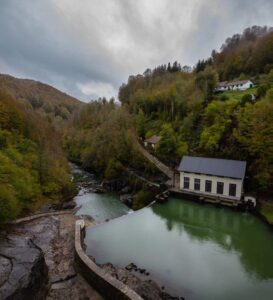
Consult your water department before you start building a dam in a existent river or stream. Photo: Cipo13, Pixabay.
Definitions and requirements
The following three definitions are given as part of the regulations, namely:
- A “dam” is defined as any structure in which water can be stored.
- A “dam with a danger risk” is defined as a dam with a storage potential of more than 50 000 cubic metres and a vertical wall height (H), measured on the downstream side of the wall, of more than 5 m. Any dam that does not comply with the above description can be declared as a dam with a safety risk if the Minister is of the opinion that such a structure is a threat to human life or public safety.
- An “Approved Professional Engineer” is defined as a professional that has been approved by the minister after consultation with the Engineering Council (ECSA) for the purposes of this series.
Requirements originating from this Act include the following:
- An owner of a dam that was built before the coming into force of the Act has to register the dam within 120 days.
- An owner of a dam that is completed after the coming into force of the Act has to register the dam within 120 days, after it is able to store or discharge water.
- An owner of a dam must comply with all the regulations in accordance with this article, regarding design, building, putting into commission, changing, enlarging or usage of the dam.
Dam classification
Each dam with a safety risk must be classified by the Director-General as a Category I, II, or III dam according to the size (maximum wall height) and the potential threat thereof. For this purpose, the threat potential is defined as an indication of the Potential Loss of Life (PLL) and Potential Economic Loss (PEL) that the failing of a dam can lead to. The separate consideration of the PLL and PEL for the resultant highest level is used. Table 3 summarises the category grouping of dams with a safety risk. The maximum wall height (H) is the height measured from the bottom of the river or stream to the crown of the wall. The measurement is done on the downstream side. Before the commencement of any construction of a new dam or the changing of an existing dam, the local Water Affairs office must be contacted for the acquisition of the necessary application forms and permits.
Published with the acknowledgement to the ARC Agricultural Engineering for the use of their manuals. Visit www.arc.agric.za for more information.









